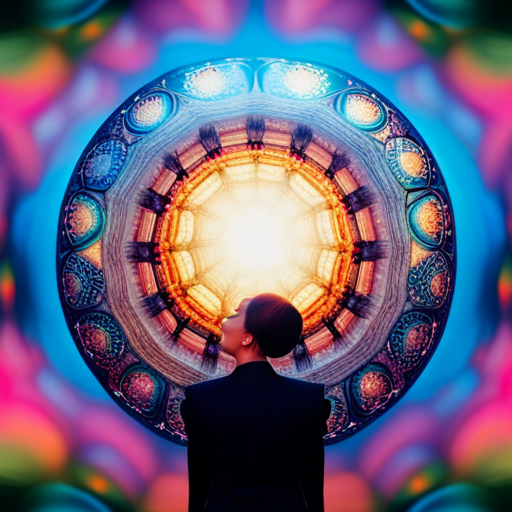Have you ever woken up from a dream feeling like you had just experienced a vivid alternate reality?
Those dreams that are so intense and lifelike, they leave you questioning their origin and meaning.
It is a curious phenomenon, why some people have such vivid dreams while others may not remember their dreams at all.
In this article, we will delve into the fascinating world of dream vividity and explore the various factors that contribute to its occurrence.
Just like a painter creates a masterpiece on a canvas, our minds paint intricate pictures during our slumber.
These vivid dreams have the power to transport us to unimaginable places, evoke strong emotions, and even mimic real-life experiences.
But what exactly triggers this heightened level of dream intensity?
Is it our psychological state, our physical health, or perhaps the sleep environment we find ourselves in?
Join me on this insightful journey as we unravel the secrets behind why someone has vivid dreams.
We will explore the role of REM sleep, psychological and physical factors influencing dream vividity, the impact of sleep quality, and even cultural and societal influences on our dreams.
By the end, you will have a deeper understanding of the fascinating world that unfolds within our minds as we sleep.
Key Takeaways
- Psychological factors such as stress, trauma, and personal experiences can influence the vividness of dreams.
- Emotional state during waking hours can impact the vividness of dreams.
- Personal beliefs and experiences contribute to the content and intensity of dreams.
- Dream recall and awareness can influence the vividness of dreams.
The Role of REM Sleep in Dream Formation
Do you ever wonder why you wake up feeling so emotionally connected to the vivid dreams that play out during your REM sleep? The answer lies in the role of REM sleep in dream formation.
REM, or Rapid Eye Movement, is a stage of sleep characterized by heightened brain activity and rapid eye movements. During this stage, our brain becomes highly active, resembling that of wakefulness. It is during REM sleep that dreams are most likely to occur.
Dream formation during REM sleep is a complex process that involves various regions of the brain. The amygdala, for example, plays a crucial role in processing emotions and is highly active during REM sleep. This heightened emotional activity is what gives our dreams their vivid and emotionally charged nature. Additionally, the prefrontal cortex, responsible for logical thinking and decision-making, is less active during REM sleep, allowing for the creation of imaginative and sometimes illogical dream scenarios.
Transitioning into the subsequent section about psychological factors influencing dream vividness, it is important to note that while the role of REM sleep is significant in dream formation, there are other factors at play as well. Psychological factors, such as stress, trauma, or even personal experiences, can greatly influence the vividness and content of our dreams.
Psychological Factors Influencing Dream Vividity
Explore the vast realm of your subconscious mind, where psychological factors seamlessly intertwine to shape the vividness of your dreams. Dream interpretation and dream symbolism play a significant role in understanding the psychological factors that influence the intensity of our dreams.
-
Emotional State: Our emotional state during waking hours can greatly impact the vividness of our dreams. When we experience intense emotions such as fear, stress, or excitement, it’s not uncommon to have more vivid and memorable dreams. These dreams may serve as an outlet for processing and dealing with our emotions.
-
Personal Beliefs and Experiences: Our personal beliefs and experiences also contribute to the vividness of our dreams. For example, someone who strongly believes in the power of symbolism may have dreams that are rich in symbolic imagery. Similarly, individuals who’ve experienced trauma may have more intense and vivid dreams as their minds attempt to process and heal from the traumatic event.
-
Dream Recall and Awareness: The level of dream recall and awareness also influences the vividness of our dreams. Those who actively engage in dream recall exercises and keep dream journals may have a greater ability to remember and interpret their dreams, leading to a deeper understanding of their psychological significance.
As we delve into the realm of physical factors affecting dream intensity, we begin to uncover the intricate relationship between our bodies and our dreams.
Physical Factors Affecting Dream Intensity
Immerse yourself in the fascinating realm of physical factors that shape the intensity of your dreams, where the connection between your body and your dream experiences comes to life. The intensity of dreams can be influenced by various neurological factors.
Our brain activity during REM sleep, the stage where dreams are most vivid, plays a significant role in dream intensity. Research suggests that increased activity in the amygdala, which is responsible for processing emotions, can lead to more vivid and intense dreams.
Additionally, medications and substances can also affect dream vividness. Certain medications, such as antidepressants and sleep aids, can alter brain chemistry and impact dream intensity. For example, antidepressants like selective serotonin reuptake inhibitors (SSRIs) have been found to decrease dream recall and intensity. Similarly, substances like alcohol and nicotine can disrupt REM sleep, resulting in less vivid dreams.
As we explore the physical factors affecting dream intensity, it becomes clear that our neurological functioning and the influence of medications and substances can significantly impact the vividness of our dreams. Understanding these factors can provide valuable insights into the nature of our dream experiences.
Transitioning into the next section about sleep environment and dream recall, we delve deeper into the external factors that shape our dream world.
Sleep Environment and Dream Recall
The sleep environment can have a massive impact on how well we remember our dreams. When our surroundings are conducive to relaxation and comfort, our minds are more likely to be at ease, allowing us to have a deeper connection with our dreams. This can lead to enhanced dream recall and a more vivid dream experience.
Dream interpretation and understanding the symbolic meanings behind our dreams can be a fascinating practice. By paying attention to the details and emotions within our dreams, we can gain insight into our subconscious thoughts and desires. This can help us better understand ourselves and provide guidance for personal growth.
Additionally, the sleep environment can also influence our ability to engage in lucid dreaming techniques. Lucid dreaming is the practice of becoming aware that you are dreaming while still in the dream state. By mastering this skill, individuals can have more control over their dreams, allowing them to explore new possibilities and experiences.
As we delve into the next section about the impact of sleep quality on dream vividity, it becomes evident that the sleep environment is just one piece of the puzzle. Other factors, such as the duration and quality of sleep, can also play a significant role in the intensity of our dreams.
Impact of Sleep Quality on Dream Vividity
Discover how the quality of your sleep can greatly enhance the vividness of your dreams. When it comes to dream recall and intensity, the impact of sleep quality cannot be underestimated. One of the key factors that influence dream vividity is the level of stress we experience. High levels of stress can lead to more intense and vivid dreams. This is because stress affects the brain’s neurotransmitters and can disrupt the normal sleep cycle, leading to more REM sleep and more vivid dreams.
Another factor that can affect dream intensity is medication. Certain medications, such as antidepressants or sleep aids, can alter the brain’s chemistry and influence the content and intensity of dreams. Some medications may cause more vivid and intense dreams, while others may suppress dream recall altogether.
To better understand the relationship between sleep quality and dream intensity, let’s take a look at the following table:
| Sleep Quality | Dream Vividity |
|---|---|
| High | High |
| Moderate | Moderate |
| Low | Low |
As you can see, there is a clear correlation between sleep quality and dream vividity. By prioritizing a good night’s sleep and managing stress levels, you can enhance the intensity and vividness of your dreams.
Now, let’s delve into the next section about dream journaling and lucid dreaming techniques.
Dream Journaling and Lucid Dreaming Techniques
After exploring the impact of sleep quality on dream vividness, it’s fascinating to delve into the realm of dream journaling and lucid dreaming techniques.
Dream journaling is a practice where one records their dreams upon waking up, capturing every detail and emotion experienced during the dream. This process not only helps in remembering dreams more vividly but also allows for deeper introspection and analysis of dream patterns and themes. By examining these recorded dreams, one can gain insight into their subconscious mind and uncover hidden desires, fears, and conflicts. This practice of self-reflection can lead to a greater understanding of oneself and promote personal growth.
On the other hand, lucid dreaming techniques involve training oneself to become aware that they’re dreaming while in the dream state. This awareness enables individuals to actively participate and manipulate the dream content, leading to a sense of control and empowerment. The benefits of lucid dreaming extend beyond mere entertainment; it’s been suggested that lucid dreaming can be used as a tool for overcoming nightmares, enhancing creativity, and even practicing real-life skills.
As we move forward and explore the connection between dream content and real-life experiences, it becomes evident that our dreams aren’t just random figments of our imagination.
The Connection Between Dream Content and Real-life Experiences
Explore the fascinating connection between dream content and your real-life experiences by analyzing how your dreams reflect and manifest your subconscious desires and fears. Dream interpretation and analysis have long been used as tools to gain insight into our innermost thoughts and emotions. By examining the symbols and themes present in our dreams, we can uncover hidden meanings and better understand our own motivations and aspirations.
Dreams often serve as a mirror of our subconscious desires and fears. For example, dreaming of flying may indicate a strong desire for freedom and adventure in our waking life. Similarly, dreaming of falling may symbolize a fear of losing control or experiencing failure. By recognizing these patterns and themes, we can gain valuable insight into our own psyche and make positive changes in our waking life.
To help illustrate this connection, consider the following table:
| Dream Symbol | Possible Interpretation | Real-life Manifestation |
|---|---|---|
| Flying | Desire for freedom and adventure | Pursuing new experiences and taking risks |
| Falling | Fear of losing control or experiencing failure | Struggling with feelings of insecurity or vulnerability |
Dream interpretation and analysis can provide a deeper understanding of ourselves and our experiences. By delving into the rich symbolism and themes present in our dreams, we can gain valuable insights that can help guide us on our life’s journey.
Transitioning into the subsequent section about ‘cultural and societal influences on dream vividity’, it is important to recognize that our dreams are not solely influenced by our own personal experiences.
Cultural and Societal Influences on Dream Vividity
Cultural and societal factors greatly impact the vividness of our dreams, revealing how our collective experiences and beliefs shape the content and emotions that arise during sleep. Dream symbolism, for example, varies across cultures, and the meanings assigned to certain symbols can influence the intensity of our dream experiences.
In some cultures, snakes may represent evil or danger, while in others they may symbolize fertility or transformation. These cultural interpretations can influence the emotions and reactions we have within our dreams.
Similarly, societal influences can also shape the vividness of our dreams. For instance, during times of societal stress or upheaval, such as war or economic instability, individuals may experience more intense and vivid dreams as a reflection of their subconscious fears and anxieties. Conversely, in more peaceful and stable societies, dreams may be more serene and less emotionally charged.
Dream interpretation is another cultural and societal factor that impacts dream vividness. Different cultures and belief systems have developed unique methods of understanding and interpreting dreams, which can influence the way individuals experience and remember their dreams. These interpretations can provide individuals with a framework for understanding the symbolism and meaning behind their dreams, enhancing their overall vividness.
Cultural and societal influences play a significant role in shaping the vividness of our dreams. By influencing dream symbolism, dream interpretation, and the emotional content of our dreams, these factors contribute to the unique and personal experiences we have while sleeping.
Transitioning into the next section, theories and research on dream vividness continue to explore the complex interplay between our subconscious and external influences.
Theories and Research on Dream Vividity
To truly understand the theories and research on dream vividness, imagine stepping into the fascinating realm where the subconscious mind unravels its mysterious tales. Dream symbolism plays a crucial role in understanding the underlying meanings and emotions behind our dreams. Researchers have found that dreams often serve as a reflection of our waking life experiences, desires, and fears.
By analyzing the symbols and themes present in our dreams, we can gain valuable insights into our subconscious thoughts and emotions. Dream interpretation is another important aspect of understanding dream vividness. Various theories and approaches have been developed to help decipher the hidden messages within our dreams. From Sigmund Freud’s psychoanalytic theory to Carl Jung’s collective unconscious, these frameworks provide different perspectives on why we dream and how to interpret our dreams.
Additionally, research has shown that individuals who actively engage in dream analysis and reflection tend to experience more vivid and memorable dreams. By delving into the theories and research on dream vividness, we unlock the potential to better understand ourselves and our subconscious minds. This understanding can lead to personal growth and self-awareness.
In the following section about tips for enhancing dream vividness and recall, we will explore practical techniques to harness the power of our dreams and delve even deeper into their mysteries.
Tips for Enhancing Dream Vividity and Recall
Immerse yourself in the enchanting world of dreams by trying out these tips to bring your dreams to life and remember them vividly. Enhancing dream visualization is key to experiencing more vivid dreams.
One way to achieve this is by keeping a dream journal. As soon as you wake up, jot down every detail you can remember about your dream. This practice not only helps with recall but also strengthens the connection between your conscious and subconscious mind.
Another tip is to engage in visualization exercises before bed. Close your eyes and imagine a specific scene or scenario that you’d like to dream about. By focusing your thoughts and intentions on this image, you’re priming your mind to manifest it in your dreams.
Dream symbols interpretation can also contribute to the vividness of your dreams. Familiarize yourself with common symbols and archetypes that often appear in dreams. This knowledge will allow you to recognize and analyze these symbols, providing deeper insights into the meaning behind your dreams.
By enhancing dream visualization and practicing dream symbols interpretation, you can unlock the full potential of your dreams. These tips won’t only make your dreams more vivid but also help you gain a better understanding of your subconscious mind.
So, dive into the realm of dreams and explore the limitless possibilities that await you.
Frequently Asked Questions
What is the impact of medication on dream vividity?
The impact of medication on dream vividness can vary depending on the specific medication. Antidepressants, for example, have been known to affect dreaming by increasing the intensity and frequency of dreams. Sleep aids, on the other hand, can potentially suppress dreams or make them less memorable.
It’s important to note that individual experiences may differ, and it’s best to consult with a healthcare professional for a more personalized understanding of how medication can influence dream vividness.
Can certain foods or drinks affect dream intensity?
Certain foods and drinks can indeed affect dream intensity. For example, consuming spicy foods before bed has been known to increase dream activity.
Additionally, alcohol and caffeine can disrupt sleep patterns and lead to more vivid dreams. It’s believed that these substances alter brain chemistry, causing the brain to produce more intense and memorable dreams.
However, more research is needed to fully understand the relationship between food, drinks, and dream intensity.
Is there a correlation between age and the vividness of dreams?
Dream quality can be influenced by various factors, and age is one of them. As we grow older, our sleep patterns change, impacting the vividness of our dreams. Research suggests that older adults tend to have less REM sleep, the stage associated with intense dreaming. This could explain why some individuals experience a decrease in dream intensity as they age.
However, it’s important to consider that other factors like stress, medication, and overall health can also affect dream vividness.
How does stress or anxiety influence dream vividness?
Stress and anxiety can significantly influence the vividness of dreams. Emotional triggers, such as a traumatic event or ongoing worry, can intensify dream imagery and emotions. When we experience high levels of stress, our sleep quality often suffers, leading to more frequent awakenings during REM sleep, the stage associated with vivid dreaming. Interrupted sleep can enhance dream recall and make the dreams feel more vivid and memorable.
Can external factors, such as noise or temperature, affect dream recall?
In the realm of dream recall, external factors such as noise or temperature can indeed play a role. Interestingly, a study conducted by researchers at the University of California found that participants who slept in a cooler environment had higher dream recall rates compared to those in warmer conditions. This suggests that temperature might influence the brain’s ability to retain and recall dreams.
Therefore, optimizing our sleep environment, including maintaining a cooler temperature, could potentially enhance dream recall.
Conclusion
In conclusion, vivid dreams can be influenced by a combination of factors, including REM sleep, psychological and physical factors, sleep environment, and sleep quality.
Additionally, dream vividity can be connected to real-life experiences and influenced by cultural and societal factors.
Theories and research on dream vividity continue to shed light on this fascinating topic.
By understanding these factors and implementing strategies to enhance dream vividity and recall, one can dive deeper into the rich and captivating world of dreams, like exploring a kaleidoscope of imagination.









